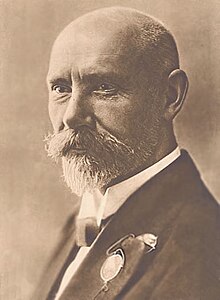Jānis Čakste
Jānis Čakste ( German Ja (h) nis Tschakste ; born September 14, 1859 Lielsesava near Jelgava ; † March 14, 1927 in Riga ) was a Latvian politician and the first president of the independent Republic of Latvia .
Life
Jānis Čakste attended high school in Mitau and studied law at Moscow University. After graduating, he worked as a lawyer in Mitau (today: Jelgava) and worked as a political activist in Latvia. He was one of the first Latvians to demand autonomy within the Russian Empire for their people . From 1888 he published the newspaper Tehwija ( Eng . "Fatherland"). He was a member of the Latvian literary society since 1901. In 1906 he was elected to the Duma , where he joined the Cadets and represented the independence movement for Latvia. After the Duma was dissolved, she was one of the signatories of the Vyborg Manifesto , which called on the population to civil disobedience.
As an opponent of the October Revolution , he fought together with the Western Allies in the Latvian War of Independence (1918–1920) against Soviet power in Latvia. On November 17, 1918 he was elected chairman of the Tautas Padome interim parliament. On May 1, 1920, the Constituent Assembly elected him President. On November 14, 1922, Čakste was elected President of Latvia, in 1925 he was re-elected. Čakste held the office until his death. His successor was Gustavs Zemgals .
Awards and honors
Čakste was the bearer of the Finnish Order of the White Rose , the Polish Order Polonia Restituta , the Belgian Leopold Order and the Estonian Cross of Freedom .
From 1928 until the Soviet occupation on June 17, 1940, today's Pils laukums (Palace Square) in Riga was named after Jānis Čakste. In 1998 the Latvian Post issued a special stamp designed by the hyper-realistic painter Miervaldis Polis in honor of Čakste . The Čakste statue for the monument in Mitau was created by Arta Dumpe .
Fonts
- The Latvians and their Latvias. A Latvian voice . Stockholm 1917.
literature
- Entry: Чаксте, Янис . In: Большая советская энциклопедия . Third edition. Издательство "Советская энциклопедия", Moscow 1969–1978 (Russian).
- Literature by and about Jānis Čakste in the catalog of the German National Library
- Literature by and about Jānis Čakste in the catalog of the Herder Institute Marburg
Footnotes
- ↑ Janīna Šuberte: Jānis Čakste un Jelgava . LU Akadēmiskais Apgāds, Riga 2006, ISBN 9984-783-68-5 , pp. 25–32.
- ↑ Adolfs Silde: Development of the Republic of Latvia . In: Boris Meissner (ed.): The Baltic Nations: Estonia, Latvia, Lithuania . Markus-Verlag, Cologne 1990, ISBN 3-87511-041-2 , pp. 63–74, here p. 63.
- ↑ Ivars Ijabs et al. a. (Ed.): Latvia 1918–2018. A century of statehood . Verlag Ferdinand Schöningh, Paderborn 2018, ISBN 978-3-506-78905-1 , p. 27.
- ↑ Ivars Ijabs et al. a. (Ed.): Latvia 1918–2018. A century of statehood . Verlag Ferdinand Schöningh, Paderborn 2018, p. 30.
- ↑ Rīgas ielu, laukumu, parku un tiltu nosaukumu rādītājs , Latvian National Library 2000, p. 125. During the Soviet occupation (until 1987) the square was called Pionieru laukums (Pioneers' Square).
Web links
- Short biography of Čakstes on the website of the Latvian Parliament
- Čakste, photos and biography (English)
- Newspaper article about Jānis Čakste in the 20th century press kit of the ZBW - Leibniz Information Center for Economics .
| personal data | |
|---|---|
| SURNAME | Čakste, Jānis |
| BRIEF DESCRIPTION | Latvian politician |
| DATE OF BIRTH | September 14, 1859 |
| PLACE OF BIRTH | Lielsesava near Jelgava |
| DATE OF DEATH | March 14, 1927 |
| Place of death | Riga |


